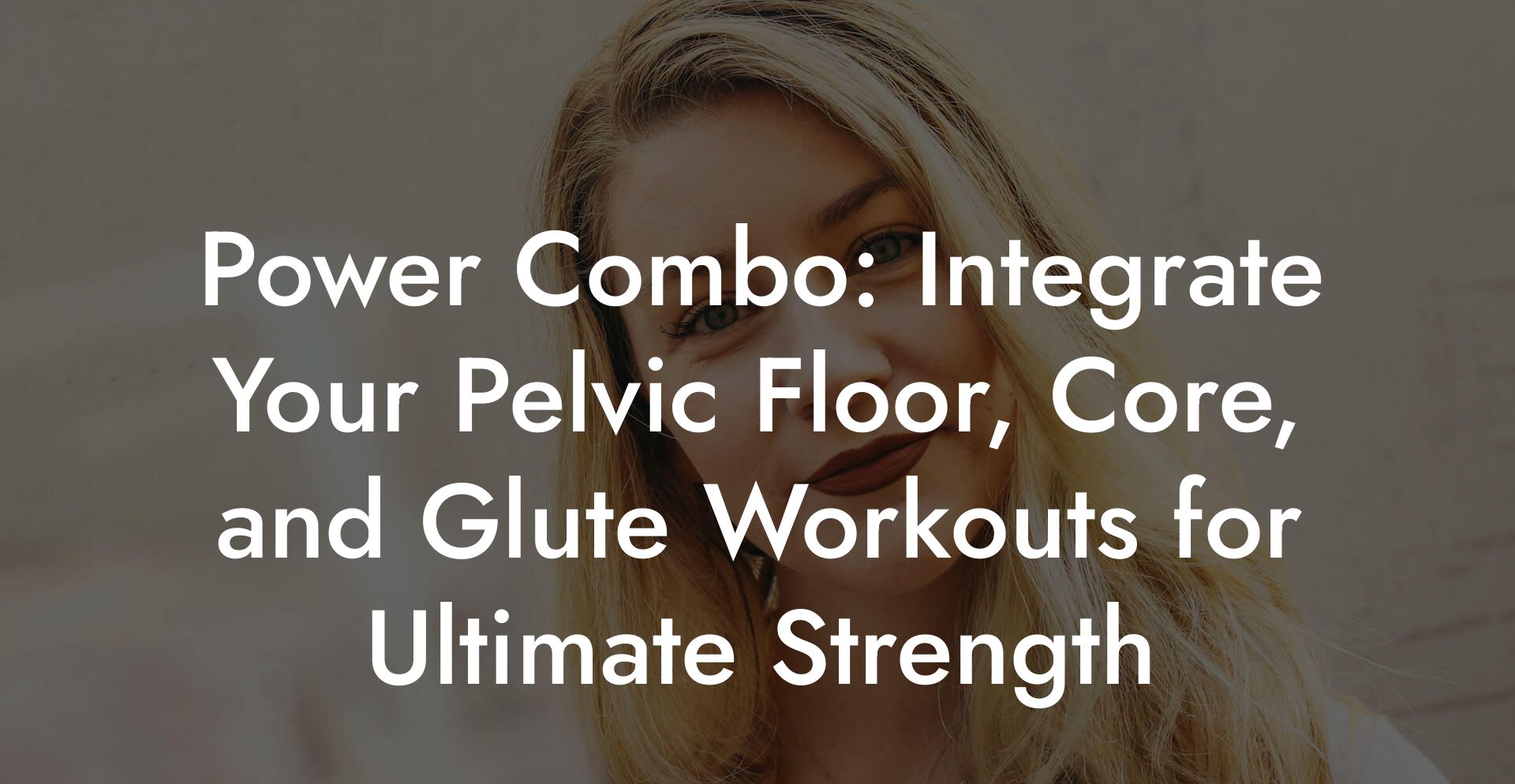
Pelvic Floor Therapy
Power Combo: Integrate Your Pelvic Floor, Core, and Glute Workouts for Ultimate Strength

When you mix the power of pelvic floor precision, core control, and glute activation, you're not just working out, you're unleashing a fitness power combo that transforms your strength from the inside out. This isn’t your typical gym routine; it’s a holistic approach that tunes your body’s foundation while boosting overall performance, stability, and confidence. Whether you’re a Gen-Z go-getter or a millennial on a mission to level up your fitness game, integrating these targeted workouts can create an explosive synergy that redefines your bodily strength.
Quick Links to Useful Sections
- The Synergy Behind Your Pelvic Floor, Core, and Glute Workouts
- Why Integration Is the Ultimate Game-Changer
- Anatomy 101: Understanding Your Pelvic Floor, Core, and Glutes
- Pelvic Floor
- Core
- Glutes
- Essential Exercises to Supercharge Your Strength Combo
- Pelvic Floor Exercises
- Core Strengthening Workouts
- Glute Activation and Strengthening
- Crafting Your Integrated Workout Routine
- How to Structure Your Routine
- Integrative Techniques for Maximum Benefit
- Form, Flexibility, and Focus: Tips for Effective Activation
- Recovery, Nutrition, and Lifestyle: Fueling Your Fitness Journey
- Prioritizing Recovery
- Eat to Fuel Your Strength
- Lifestyle Habits That Amplify Your Results
- Resources and Community Support: Your Next Steps
- Frequently Asked Questions About the Integrated Power Combo
- Your Journey to Unstoppable Strength: Embrace the Power Combo
The Synergy Behind Your Pelvic Floor, Core, and Glute Workouts
Picture this: your body as a well-designed, high-performance machine. Every time you engage your pelvic floor, core, and glutes simultaneously, you’re not only strengthening individual muscles, you’re upgrading your entire support system. This unbeatable trio plays a critical role in stabilizing your spine, optimizing posture, and safeguarding your joints. The pelvic floor, for instance, supports your organs and improves bladder control, while the core acts as the powerhouse the center, and your glutes provide the explosive strength for movements from squats to sprints.
In a world where body image and functionality are inextricably linked, integrating these exercises provides the kind of wholesome, balanced training that goes beyond aesthetics. It’s like upgrading your software to the latest version: the performance is just smoother, more responsive, and built for the long haul.
Beyond the obvious physical benefits, embracing this integrated workout routine also promotes better mind–body awareness. When you consciously activate these key muscle groups, you develop a heightened connection with your body. This means more precise movements, improved alignment, and a deeper understanding of how to prevent injuries during everyday activities and athletic endeavors.
Why Integration Is the Ultimate Game-Changer
Modern fitness isn’t about isolating muscles, it’s about integration. Think of it as the difference between having a squad of solo artists versus a full band performing in perfect harmony. Sure, you might nail a single instrument in isolation, but when everything comes together, the performance is unparalleled.
Your pelvic floor affects how you move, how you use the bathroom, and how sex feels, yet most men are never taught how it works. This essential guide explains your pelvic floor in plain language and gives you a simple plan to relax, strengthen, and look after it at home.
Youll Learn How To:
- Understand what your pelvic floor does for bladder control, posture, and sex
- Spot signs of tension, weakness, and poor coordination
- Use breathing, reverse Kegels, and classic Kegels safely
- Improve habits for sitting, lifting, sport, sleep, and stress
Whats Inside: friendly explanations, safety guidelines, daily drills, sex function tools, flare up plans, and a complete twelve week program with trackers.
Perfect For: men of all ages who want less pelvic tension, fewer leaks, better comfort on the toilet, and more confidence in movement and in the bedroom.
Focusing on pelvic floor, core, and glute workouts simultaneously yields several transformative benefits:
- Enhanced Stability: By working these muscle groups together, you build a robust inner foundation that stabilizes your spine, minimizes lower back pain, and improves balance.
- Improved Posture: Strengthening the core and glutes contributes directly to better posture, thereby reducing the strain on your neck and shoulders from daily tech use.
- Injury Prevention: A resilient core supports nearly every movement you make, meaning you're less likely to suffer strains, sprains, or other injuries.
- Increased Athletic Performance: Whether you're an athlete or just love a killer dance-off at your next party, an integrated workout can boost your endurance, speed, and overall performance.
- Holistic Wellness: This approach not only targets physical strength but also enhances pelvic floor health, a crucial aspect for both men and women that is too often neglected.
Integrating these workouts can feel challenging at first, as if you’re juggling multiple tasks at once, but with a bit of practice and consistency, they become a natural, empowering part of your fitness regime.
Anatomy 101: Understanding Your Pelvic Floor, Core, and Glutes
Knowledge is power, especially when it comes to training the body parts that often go unnoticed. Let’s break down what each of these components contributes to your overall strength and how targeted exercises can work wonders:
Pelvic Floor
The pelvic floor is a network of muscles, ligaments, and connective tissues located at the base of your spine. These muscles hold up your organs, regulate bladder and bowel function, and even contribute to sexual health. For women, regular pelvic floor exercises can prevent or alleviate issues like incontinence or pelvic organ prolapse. For men, it aids in recovery post-prostate surgery and supports overall genitourinary health.
Integrating pelvic floor exercises with core and glute workouts magnifies their effects, as the surrounding muscles work in tandem to provide stability and prevent undue strain.
Core
When gym enthusiasts talk about “abs,” they’re only scratching the surface of the core. Your core includes the rectus abdominis, obliques, transverse abdominis, and even the lower back muscles. This region is the epicenter of all human movement; a strong core not only contributes to better posture but is also essential for virtually every physical activity.
By pairing core exercises with pelvic floor work and glute activation, you can create a functional powerhouse that enhances everyday movements and athletic performance.
Glutes
The gluteal muscles are among the strongest in your body, crucial for movements like walking, running, and jumping. These muscles help shape your buttocks and play a vital role in hip stability and alignment. Strengthening your glutes will not only elevate your physical performance but also alleviate common issues such as lower back pain and knee strain.
When integrated with pelvic floor and core exercises, glute workouts help create a support system that channels power efficiently through your entire body.
Essential Exercises to Supercharge Your Strength Combo
Ready to dive into the nitty-gritty details of how to combine pelvic floor, core, and glute exercises? Here’s your ultimate exercise guide, complete with variations to suit beginners, intermediates, and even the fitness-savvy.
Your pelvic floor affects how you move, how you use the bathroom, and how sex feels, yet most men are never taught how it works. This essential guide explains your pelvic floor in plain language and gives you a simple plan to relax, strengthen, and look after it at home.
Youll Learn How To:
- Understand what your pelvic floor does for bladder control, posture, and sex
- Spot signs of tension, weakness, and poor coordination
- Use breathing, reverse Kegels, and classic Kegels safely
- Improve habits for sitting, lifting, sport, sleep, and stress
Whats Inside: friendly explanations, safety guidelines, daily drills, sex function tools, flare up plans, and a complete twelve week program with trackers.
Perfect For: men of all ages who want less pelvic tension, fewer leaks, better comfort on the toilet, and more confidence in movement and in the bedroom.
Pelvic Floor Exercises
The cornerstone of your pelvic power routine involves exercises that activate and strengthen the pelvic floor muscles. Two essential moves include:
- Kegels: The classic exercise for pelvic floor strengthening. Engage your pelvic muscles as if you’re trying to stop the flow of urine, hold for a few seconds, and then release. Aim for sets of 10–15 repetitions daily.
- Reverse Kegels: These involve gently relaxing and lengthening the pelvic muscles after a contraction, which helps balance the workout. Perfect for those dealing with pelvic tension or stress.
Incorporating these into your warm-up or cool-down routine can drastically improve bladder control and overall pelvic health.
Core Strengthening Workouts
The core is your personal powerhouse, and here are some strategies to fortify it:
- Planks: A timeless exercise that engages your entire midsection. Start with a basic front plank, ensuring your body is in a straight line from head to toe, and hold for 30–60 seconds.
- Russian Twists: This twisty movement activates the oblique muscles. Keep your core engaged and twist side-to-side with a moderate weight to challenge your stability.
- Bicycle Crunches: Alternate touching your elbow to the opposite knee, ensuring controlled, fluid movements that energize your abdominals and obliques simultaneously.
- Dead Bugs: This exercise helps you practice stability by keeping your core engaged as you alternate extending your arms and legs.
These core exercises not only build raw strength but also improve functional movement, making daily tasks and athletic activities more efficient.
Glute Activation and Strengthening
Your glutes are all about explosive power and stability; here are some of the best exercises to engage them:
- Squats: The king of all lower body exercises. Focus on keeping your chest up, knees tracking over your toes, and squatting deeply enough to really feel the burn in your glutes and thighs.
- Lunges: Step forward, keeping your torso upright, and lower your hips until both knees are bent at about a 90-degree angle. Variations include walking lunges and reverse lunges, which can help target different parts of your glutes.
- Hip Thrusts: With your shoulders on a bench and a weighted barbell or bodyweight at your hips, thrust upward by squeezing your glutes at the top of the movement for maximum engagement.
- Glute Bridges: Similar to hip thrusts, but performed on the floor. This is a great beginner exercise that can be done anywhere, focusing on controlled movement and full muscle engagement.
For an extra challenge, try incorporating resistance bands or weights to amplify the muscle burn and strength gains.
Crafting Your Integrated Workout Routine
Now that you understand the individual components, it’s time to craft a killer workout that combines pelvic floor, core, and glute exercises into one seamless routine. The key is to strike a balance between targeted activation and compound movements that benefit from every muscle group working together.
How to Structure Your Routine
Begin by dedicating time to a warm-up that includes dynamic stretches and a few gentle pelvic floor activations to get your body ready. Then, follow a circuit-style training session that rotates between pelvic floor exercises, core-strengthening moves, and glute activations. For example:
- Warm-Up (5–10 minutes): Light cardio (jumping jacks, brisk walking), dynamic stretching (leg swings, arm circles), and 2–3 sets of gentle Kegels.
- Main Workout (30–45 minutes):
- Circuit 1: 1 set of 15 Kegels, 30-second plank, and 15 squats.
- Circuit 2: 10 reverse Kegels, 20 bicycle crunches, and 12 lunges on each leg.
- Circuit 3: 15 glute bridges mixed with 30-second dead bugs.
- Cool-Down (5–10 minutes): Static stretching focusing on the pelvic region, abdominals, and lower body, along with some mindful deep breathing exercises.
Adjust the repetitions, sets, and rest periods according to your current fitness level. Over time, as your proficiency increases, you can alter your routines by adding resistance or increasing the duration of certain exercises.
Integrative Techniques for Maximum Benefit
Consider employing the following techniques to elevate your workout:
Your pelvic floor affects how you move, how you use the bathroom, and how sex feels, yet most men are never taught how it works. This essential guide explains your pelvic floor in plain language and gives you a simple plan to relax, strengthen, and look after it at home.
Youll Learn How To:
- Understand what your pelvic floor does for bladder control, posture, and sex
- Spot signs of tension, weakness, and poor coordination
- Use breathing, reverse Kegels, and classic Kegels safely
- Improve habits for sitting, lifting, sport, sleep, and stress
Whats Inside: friendly explanations, safety guidelines, daily drills, sex function tools, flare up plans, and a complete twelve week program with trackers.
Perfect For: men of all ages who want less pelvic tension, fewer leaks, better comfort on the toilet, and more confidence in movement and in the bedroom.
- Mindful Movement: Focus on form over speed. Each contraction and relaxation phase should be deliberate to ensure maximum muscle engagement and prevent injury.
- Controlled Breathing: Coordinate your breath with the exercise. Exhale during the exertion phase (e.g., when lifting or contracting) and inhale during the resting phase to enhance oxygen flow and muscle recovery.
- Progress Tracking: Use a fitness journal or mobile app to monitor your progress, record the number of reps and sets, and note improvements in form or endurance.
- Visual Cues: Occasionally use mirrors or video feedback to ensure correct posture and alignment. This not only helps with technique but also reinforces mind–body awareness.
Integrating these techniques makes your workout more effective and significantly reduces the risk of injury while keeping you motivated throughout your fitness journey.
Form, Flexibility, and Focus: Tips for Effective Activation
A perfectly choreographed workout isn’t just about performing exercises in sequence, it’s about ensuring perfect form, adequate flexibility, and laser-sharp focus. Here are some tips to help you get the most out of your integrated routine:
- Maintain Alignment: Whether you’re doing squats or planks, proper alignment is crucial. Keep your shoulders back, core engaged, and knees tracking over your toes. This alignment not only optimizes muscle engagement but also wards off injuries.
- Engage Your Mind: Avoid mindlessly going through the motions. Instead, concentrate on each muscle group as you work it. This mindful approach helps reinforce the connection between your brain and body, enhancing overall effectiveness.
- Warm-Up and Cool-Down: Never underestimate the importance of a thorough warm-up and cool-down. These sessions prepare your muscles for rigorous activity and relax them post-workout, which is essential for preventing soreness and injuries.
- Use Modifications: Listen to your body. If you’re experiencing any pain or discomfort, modify the exercise. Whether that means reducing the number of repetitions or using a support (like a wall or chair), it’s important to prioritize safety.
- Mix It Up: To prevent plateauing, vary your routines. Alternate between high-intensity sessions and more moderate, recovery-focused workouts to keep your muscles guessing and growing.
With these tips, every session becomes a deliberate act of self-improvement, empowering you to push past boundaries and redefine what you thought was possible.
Recovery, Nutrition, and Lifestyle: Fueling Your Fitness Journey
The best workouts in the world can only take you so far if you’re not fueling your body appropriately. Recovery, nutrition, and holistic lifestyle choices are crucial elements that work in tandem with your training routine to deliver long-term results.
Prioritizing Recovery
Recovery is when your muscles rebuild and grow stronger. Here are some strategies:
- Rest Days: Plan regular rest days to allow your muscles to recover adequately. Overtraining can lead to injuries and compromise the very progress you’re working towards.
- Stretching and Foam Rolling: Incorporate gentle stretching and foam rolling sessions to alleviate muscle tightness and promote blood flow to the hard-working muscles.
- Mindful Relaxation: Practices like meditation or even calming music can help reduce cortisol levels, contributing to faster recovery.
Eat to Fuel Your Strength
Integrating a balanced, nutrient-rich diet into your routine not only accelerates recovery but also enhances performance:
- Anti-Inflammatory Foods: Incorporate fruits, leafy greens, nuts, and fatty fish that help reduce inflammation and support muscle healing.
- Lean Proteins: Proteins are the building blocks for muscle repair. Options like chicken, tofu, legumes, or fish should be part of your meal arsenal.
- Hydration: Don’t forget to drink water. Staying hydrated ensures elasticity in your muscles and joints, aiding in smooth, coordinated movements during workouts.
Lifestyle Habits That Amplify Your Results
Beyond the gym, your daily habits contribute to your overall fitness journey. Whether it’s ensuring you get enough quality sleep, managing stress through mindfulness techniques, or simply maintaining a consistent daily schedule, these factors can supercharge your training results.
Incorporate routines that support your wellness goals, such as evening wind-down rituals, periodic breaks during work to stretch and move, and engaging in activities that boost both mental clarity and physical performance. When you view nutrition, recovery, and daily habits as integral parts of your fitness journey, you cultivate a lifestyle centered around sustainable strength and longevity.
Resources and Community Support: Your Next Steps
Remember, the journey to ultimate strength isn’t one you have to travel alone. There are countless resources and communities waiting to support your integrative workout lifestyle. From online fitness forums to local workout classes and pelvic health specialists, finding a network that understands and encourages your goals can make all the difference.
Look for reputable websites that offer tutorials and progress tracking tools, explore apps that guide you through mindful workouts, or join social media groups where fellow fitness enthusiasts share success stories and practical tips. Whether you’re looking for advice on pelvic floor exercises, core strengthening routines, or advanced glute activation techniques, community support is an invaluable asset.
Don’t be shy about reaching out to professionals who can fine-tune your technique or offer insights on how to integrate these workouts into your daily routine seamlessly. From personal trainers to wellness coaches that emphasize pelvic floor therapy techniques, an informed network can help you overcome challenges and celebrate victories.
As you explore these platforms and communities, remember that every bit of shared knowledge, every success story, and every expert tip adds a valuable piece to your personal journey toward a more empowered, healthier body.
Frequently Asked Questions About the Integrated Power Combo
Here are some of the most common questions about integrating pelvic floor, core, and glute workouts, answered in a straightforward, relatable way to help you optimize your training regimen.
1. What are the benefits of integrating pelvic floor, core, and glute workouts?
This integrated approach creates a unified support system that improves stability, posture, and athletic performance while helping prevent injury. It ensures that your body works as a cohesive unit, leading to improved overall functionality and enhanced pelvic floor health.
2. How often should I incorporate these workouts into my weekly routine?
Start with 2–3 dedicated sessions per week focused on these muscle groups, and gradually increase the frequency as your strength and endurance improve. Mixing them with general fitness activities and rest days will promote balanced recovery.
3. I suffer from pelvic floor issues. Are these workouts safe?
Absolutely, but it’s important to start slowly and make modifications as needed. Consulting with a pelvic floor specialist or physical therapist can provide personalized recommendations to ensure you perform exercises safely.
4. What specific exercises should I focus on for each area?
For your pelvic floor, Kegels and reverse Kegels are essential. Core exercises like planks, Russian twists, and bicycle crunches help fortify your midsection, while squats, lunges, and glute bridges effectively target and activate your glutes.
5. Is maintaining proper form really that important?
Yes, correct form is crucial for maximizing benefits and preventing injuries. Prioritize quality over quantity by focusing on mindful, controlled movements and proper alignment.
6. Can I combine these workouts with other forms of exercise?
Definitely! These exercises complement a wide range of activities such as running, yoga, or strength training, contributing to a well-rounded fitness routine.
7. How long before I see noticeable improvements?
Consistency is key. With regular practice, most individuals begin to notice improvements in strength, stability, and overall pelvic health within 4–6 weeks.
8. Can these exercises help with lower back pain?
Yes, by strengthening the core and improving pelvic stability, these targeted workouts can alleviate chronic lower back pain and enhance overall posture.
9. Should I consult a professional before starting this routine?
If you have any existing health concerns, consider speaking with a healthcare provider or pelvic floor specialist prior to starting any new exercise program. They can offer personalized guidance and modifications suited to your needs.
10. Are there any high-tech tools to help with these workouts?
Yes, devices like biofeedback monitors and mobile apps designed for pelvic floor training can provide real-time feedback, helping you optimize your form and track progress.
Your Journey to Unstoppable Strength: Embrace the Power Combo
Integrating pelvic floor, core, and glute workouts isn’t just about building a strong body, it’s about empowering every aspect of your movement and well-being. Every rep, every mindful contraction, and every deep breath pushes you closer to a level of strength that transcends the gym.
Whether you're smashing it in your workout sessions or simply navigating everyday life with enhanced balance and confidence, this integrative approach is your secret weapon. Embrace the challenges, celebrate the victories, and know that every step you take is more than just physical, it’s a journey toward a resilient, empowered you.
Today marks the start of a new era in fitness. One where pelvic floor exercises, core strengthening, and glute activation converge to create a dynamic, unstoppable force. With dedication, the right guidance, and a community that cheers you on, you’re not just working out, you’re redefining your limits.
So, gear up, dive into these routines, and let the power combo transform not only your body but your entire approach to health and wellness. Your new, empowered strength begins here and now, one mindful, integrated workout at a time.
Your pelvic floor affects how you move, how you use the bathroom, and how sex feels, yet most men are never taught how it works. This essential guide explains your pelvic floor in plain language and gives you a simple plan to relax, strengthen, and look after it at home.
Youll Learn How To:
- Understand what your pelvic floor does for bladder control, posture, and sex
- Spot signs of tension, weakness, and poor coordination
- Use breathing, reverse Kegels, and classic Kegels safely
- Improve habits for sitting, lifting, sport, sleep, and stress
Whats Inside: friendly explanations, safety guidelines, daily drills, sex function tools, flare up plans, and a complete twelve week program with trackers.
Perfect For: men of all ages who want less pelvic tension, fewer leaks, better comfort on the toilet, and more confidence in movement and in the bedroom.
Curious About Your Pelvic Floor? Explore our curated collection of insightful articles to learn more and take charge of your health.
- Pelvic Floor Basics
- Pelvic Floor Exercises & Workouts
- Pelvic Floor Kegel Exercises: Techniques & Benefits
- Advanced Pelvic Floor Workouts
- Pre/Post-Natal Pelvic Floor Routines
- Pelvic Floor Exercises for Men
- Pelvic Floor Therapy Techniques
- At-home vs Professional Pelvic Floor Therapy Options
- Diet & Lifestyle for a Healthy Pelvic Floor
- Pelvic Floor Health & Wellness
- Specialized Pelvic Floor Conditions & Treatments
Now back to the main article!















